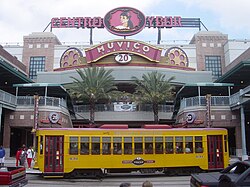Centro Ybor
| Ybor City | |
|---|---|
| Neighborhood | |

Centro Ybor complex with a TECO Line car passing in front
|
|
| Nickname(s): Florida's Latin Quarter | |
| Coordinates: 27°57′41″N 82°26′42″W / 27.96139°N 82.44500°WCoordinates: 27°57′41″N 82°26′42″W / 27.96139°N 82.44500°W | |
| Country | United States |
| State | Florida |
| County | Hillsborough County |
| City | Tampa |
| Founded | 1885 |
| Incorporation into Tampa | 1887 |
| Time zone | EST (UTC-5) |
| • Summer (DST) | EDT (UTC-4) |
| Website | https://www.yborcityonline.com/ |
Ybor City (/ˈiːbɔːr/ EE-bor) is a historic neighborhood in Tampa, Florida, United States, located just northeast of downtown. It was founded in the 1880s by Vicente Martinez-Ybor and other cigar manufacturers and was populated by thousands of immigrants, mainly from Cuba, Spain, and Italy. For the next 50 years, workers in Ybor City's cigar factories rolled hundreds of millions of cigars annually.
Ybor City was unique in the American South as a successful town almost entirely populated and owned by immigrants. The neighborhood had features unusual among contemporary communities in the south, most notably its multi-ethnic and multi-racial population and their many mutual aid societies. The cigar industry employed thousands of well-paid workers, helping Tampa grow from an economically depressed village to a bustling city in about 20 years and giving it the nickname "Cigar City".
Ybor City grew and flourished from the 1890s until the Great Depression of the 1930s, when a drop in demand for fine cigars reduced the number of cigar factories and mechanization in the cigar industry greatly reduced employment opportunities in the neighborhood. This process accelerated after World War II, and a steady exodus of residents and businesses continued until large areas of the formerly vibrant neighborhood were virtually abandoned by the late 1970s. Attempts at redevelopment failed until the 1980s, when an influx of artists began a slow process of gentrification. In the 1990s and early 2000s, a portion of the original neighborhood around 7th Avenue developed into a night club and entertainment district, and many old buildings were renovated for new uses. Since then, the area's economy has diversified with more offices and residences, and the population has shown notable growth for the first time in over half a century.
...
Wikipedia

